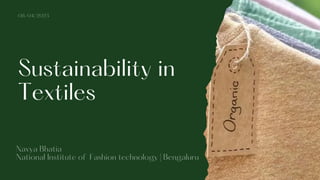This document discusses sustainability in the textiles industry. It begins by defining sustainability and its three pillars of economy, society and environment. It then discusses the textiles industry, describing the various processes involved and its large economic and employment impact. However, it also notes that textiles are the 2nd most polluting industry, using vast resources and chemicals. The document then explores various ways for the industry to move towards more sustainability, such as using organic, recycled and alternative materials. It also discusses eco-friendly dyeing, finishing and packaging processes. It concludes by looking at sustainable supply chain management and reducing the environmental impact of textile transportation.
























